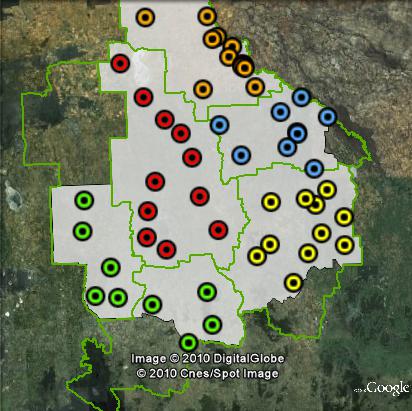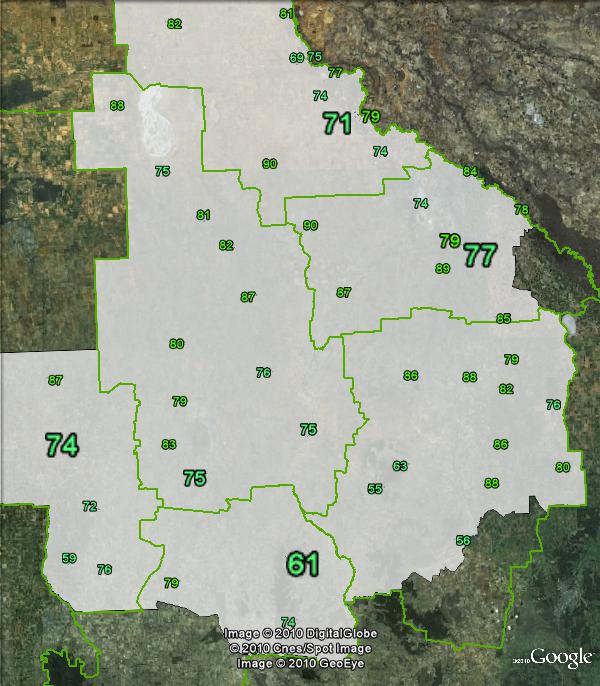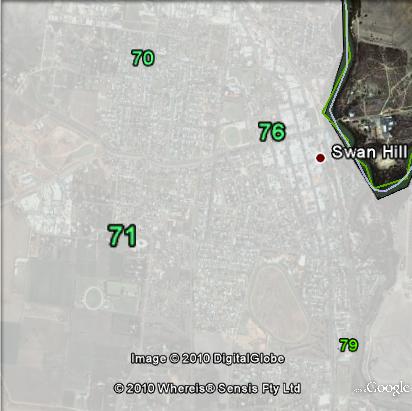NAT 23.4%
Incumbent MP
Peter Walsh, since 2002.
Geography
Northwestern Victoria. Swan Hill covers a large part of northern Victoria stretching from the Murray River down to areas between Horsham and Bendigo (although it does not cover either of those towns).
It covers the town of Swan Hill as well as Birchip, Charlton, Donald, Kerang, Murtoa, St Arnaud, Sea Lake, Warracknabeal, Wedderburn and Wycheproof. The seat covers all or part of Buloke, Gannawarra, Loddon, Northern Grampians, Swan Hill and Yarriambiack local government areas.
History
Swan Hill has existed as a Legislative Assembly district since 1904. It has been held by the Country/National Party for most of the period since 1917, apart from a few periods of the Liberal Party holding the seat.
The seat was won in 1917 by Percy Stewart of the Victorian Farmers Union. He resigned from Swan Hill to win the federal seat of Wimmera in 1919. He helped form the Country Party in the federal Parliament. He held Wimmera until his death in 1931.
The 1919 Swan Hill by-election was won by Francis Old. He served as deputy leader of the Country Party from 1922 to 1924 and again from 1936 to 1937. He served as a minister from 1923 to 1924 and again from 1935 to 1943, serving as Deputy Premier from 1936 to 1937. He held Swan Hill until 1945.
John Hipworth won Swan Hill for the Country Party in 1945. He switched to the Liberal Party in 1949 and managed to win re-election in 1950, but he lost his seat in 1952.
Harold Stirling held Swan Hill for the Country Party from 1952 until his death in 1968. Henry Broad won Swan Hill at the 1968 by-election, also for the Country Party.
Broad was defeated by the Liberal Party’s Alan Wood in 1973. Wood served as a minister in the state government from 1979 to 1982, and resigned from Parliament in 1983 following the defeat of the Liberal government at the 1982 election.
Barry Steggall won Swan Hill back for the National Party in 1983. He served for 19 years in Parliament, serving as deputy leader of the Nationals from 1999 until his retirement at the 2002 election.
In 2002, Swan Hill was won by Peter Walsh, a former President of the Victorian Farmers Federation running for the Nationals. He was re-elected in 2006 with a 9.25% swing.
Candidates
- Peter Walsh (Nationals)
- Sharon Garrick (Labor)
- Garion Pearse (Family First)
- Morgana Russell (Greens)
Political situation
Swan Hill is a very safe Nationals seat.
2006 result
| Candidate | Party | Votes | % | Swing |
| Peter Walsh | NAT | 14,302 | 47.43 | +12.59 |
| Suellen Tomamichel | LIB | 7,541 | 25.01 | -1.57 |
| Glenn Morrison | ALP | 5,582 | 18.51 | -7.90 |
| Simon Roberts | GRN | 1,189 | 3.94 | -1.21 |
| Martin Jones | FF | 1,004 | 3.33 | +3.33 |
| Trudy Campbell | CEC | 534 | 1.77 | +1.77 |
2006 two-candidate-preferred result
| Candidate | Party | Votes | % | Swing |
| Peter Walsh | NAT | 22,152 | 73.40 | +9.25 |
| Glenn Morrison | ALP | 8,029 | 26.60 | -9.25 |
Despite the Liberals clearly outpolling the ALP, the only available two-candidate-preferred figure available is that done between the Nationals and the ALP, as the ALP came second in 2002, and the Nationals managed to gain a majority of the vote without excluding the ALP. This turns out to be more helpful, since no Liberal is running in 2010.
Booth breakdown
Polling booths in Swan Hill have been divided based on local government areas. Booths in Swan Hill, Gannawarra, Buloke and Loddon have been grouped by local government areas. Booths in Northern Grampians and Yarriambiack have been combined as “Southwest”.
The Nationals majority varied from 68.5% in the southwest to almost 79% in Gannawarra.

| Voter group | NAT 2CP % | Total votes | % of votes |
| Swan Hill | 74.43 | 7,638 | 25.31 |
| Southwest | 68.53 | 5,053 | 16.74 |
| Gannawarra | 78.97 | 4,293 | 14.22 |
| Buloke | 76.93 | 3,997 | 13.24 |
| Loddon | 71.02 | 3,357 | 11.12 |
| Other votes | 71.11 | 5,843 | 19.36 |



